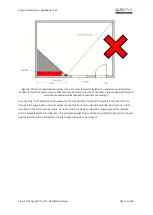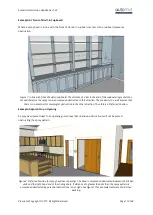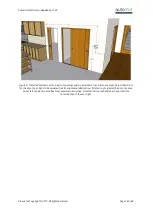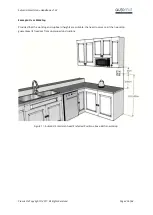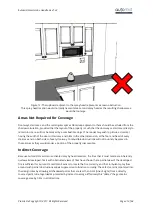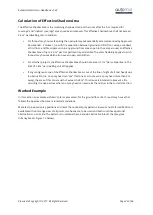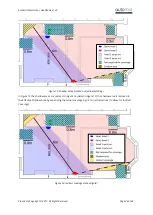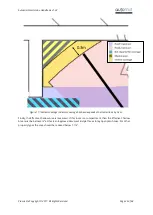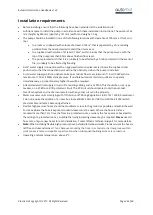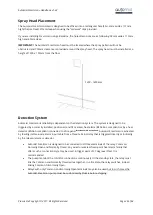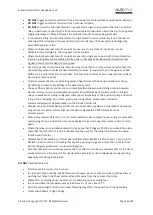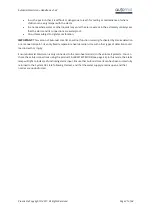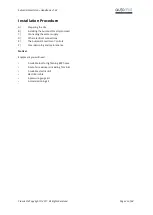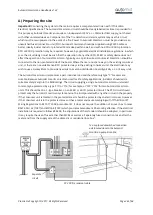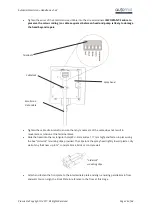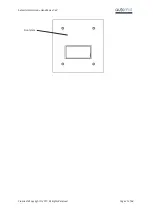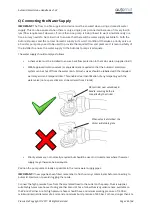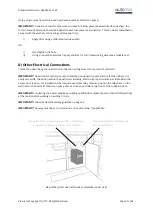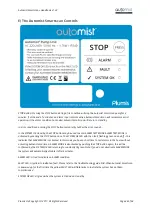
Automist Smartscan
®
Handbook v1.2.3
Plumis Ltd Copyright © 2017. All Rights Reserved.
Page 30 of 64
S MA RT SC AN
®
•
DO NOT
trigger Automist Smartscan from a smoke alarm as this will lead to unwanted activations.
•
DO NOT
trigger Automist Smartscan from a manual call point.
•
DO NOT
connect the Automist Smartscan
pump’s alarm input to any device other than a volt free
relay. In particular, connecting the three coloured cables to the alarm interconnect or to any power
supply whatsoever is likely to damage the Automist Smartscan pump beyond repair.
•
In its default setting, Automist Smartscan is programmed to run continuously for 30 minutes on
activation. This is designed to prevent interruption of mist even if a heat alarm is damaged by
extended exposure to fire.
•
Where multiple Automist Smartscan units are used, each must take its input from its own
dedicated relay module e.g. the relay base of a heat alarm.
•
Where multiple Automist Smartscan units are used in a single space, each with its own detection,
there is no requirement to activate all relay units in that space simultaneously if detectors will
signal a fire out of the range of a spray head.
•
Fire alarm panels can add Automist Smartscan by connection to a relay output provided that this
operates only when the relevant heat detector(s) activate. If requested by a fire engineer, SLAVE
MODE can be ordered at time of purchase. This sets Automist Smartscan to operate only while its
alarm input remains active.
•
Plumis recommends the use of mains powered heat alarms with back-up batteries since they
significantly increase the reliability of the detection system.
•
Ten-year lithium battery alarms are an acceptable alternative when installing a mains-powered
alarm and relay causes unacceptable disruption. Wired lithium battery alarms with an integral
relay are available: correctly configured, these report low battery to the Automist pump and cause
it to go into a “beeping” error state, greatly improving safety: please refer to Plumis’s
recommended alarms documentation on the Plumis Partner Site.
•
Wireless ten-year lithium battery alarms are recommended only where a scheduled maintenance
programme is in place. Alarms that use standard replaceable 9V PP3 batteries are not
recommended.
•
When using wireless detection, it is not recommended to use complex house coding schemes with
overlapping zones, as installer errors can easily lead to incorrect operation and are hard to track
down.
•
Where the relay is not installed adjacent to the pump that it triggers, FP200 or a suitable fire alarm
cable that resists fire for at least 30 minutes must be used for the cable run between the pump
location and the relay.
•
Placement of heat detectors / alarms should follow either BS5839-6:2013 section 11.2 (h) to (n) or
BS5839-1:2013 section 22.3. Notably this implies a working range of no more than 5.3m for heat
alarms and gives guidance on unusual ceiling types.
•
Automist Smartscan’s use of heat alarms does not affect or reduce any requirements for the use of
smoke detection in the property. Smoke detection provides a critical independent early warning,
especially with slow-growing fires.
DO NOT
install heat alarms:
•
Directly over the cooker, stove or oven.
•
In areas with high humidity, like bathrooms or shower rooms, or areas to close to dishwashers or
washing machines. Install heat alarms at least 3m away from these areas if possible.
•
Adjacent to, or directly above, heaters, air-conditioning vents or ceiling fans.
•
In an area where the temperature may fall below 4°C or rise above 37°C.
•
Near fluorescent lights. Electrical noise & flickering may affect the operation of the heat alarm.
•
Closer than 300mm to light fittings.

